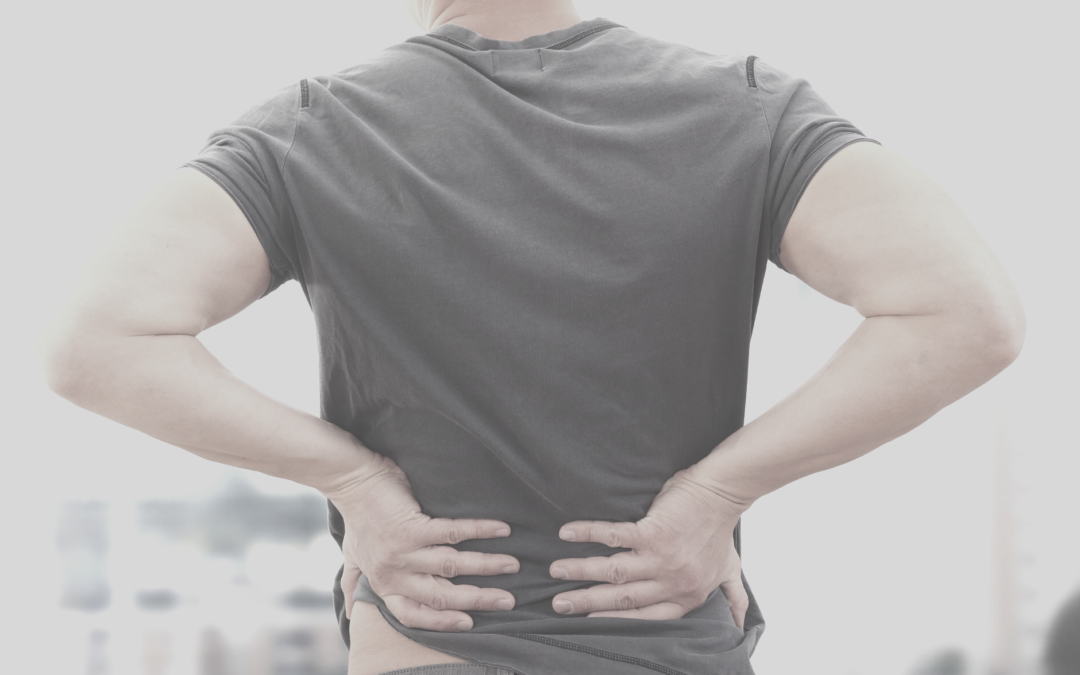I’m sure you’ve been told again and again to use your knees and to keep your back straight when you lift things from the floor or a shelf, to avoid doing twisting movements doing so, and to be aware of your posture. And as much as you hear it and agree on the moment, you may not always apply it when you’re back home or at work. Habits are habits and changing it may feel more like a constraint, and for what benefit?
Well, maybe if we explain why it’s important for the long term to do it properly and consistently, and the consequences a bad posture would have on your body, you’ll start to see it differently and pay more attention to it. I’m pretty sure you’d be surprised to know how much forces are being applied to your body and how much of an impact it is on it.
Anatomy
But first, a little bit of anatomy to give you a better understanding of what is involved, what is impacted and how it is designed in your body.
The standard vertebra
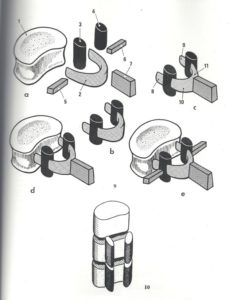 When we look at the different parts which compose a standard vertebra, we can see it is constituted in 2 main parts…the vertebral body in the front and the posterior arc in the back.
When we look at the different parts which compose a standard vertebra, we can see it is constituted in 2 main parts…the vertebral body in the front and the posterior arc in the back.
The vertebral body is the massive part of the vertebra.
The posterior arc is horseshoe shaped and is constituted by different parts itself:
– The articular processes which are the posterior joints between vertebrae (in black on the picture)
– The transverse processes (pointy bony things going to each sides)
– The spinal process (pointy bony thing going to the back)
This structure of the standard vertebra can be found at every level of the spine with of course some changes due to the specificities of the area, so a cervical vertebra will be different from a thoracic or lumbar one but they will share the same organization, the same base.
It’s interesting to note that the different constitutive parts are matching from a vertebra to the other one vertically. That way, all along the spine we can find 3 columns:
– 1 main column in the front constituted by all the vertebral bodies
– 2 secondary columns in the back constituted by all the articular processes
It’s interesting because we can see that when we stand straight, the weight of the body is supported by 3 points.
 The vertebral bodies are united by the intervertebral discs.
The vertebral bodies are united by the intervertebral discs.
The intervertebral disc
The disc is constituted by 2 parts:
– The nucleus pulposus, in the middle, a ball of gelatinous substance composed by water at 88%
– The annulus fibrosus, peripheral, composed by a succession of concentric layers of fibers, surrounding the nucleus pulposus and maintaining its substance under pressure.
Physics
I know, this word doesn’t ring like a dream for a lot of people, but it’s actually very important and interesting to get the “How” and the “Why”. We’ll keep it simple, don’t worry. The most important notions here are about forces and levers.
Forces
![]() When in a standing position, the pressure applied on the last lumbar disc (L5-S1) is determined by the weight of the trunk, head, arms and shoulders, which represent about 2/3 of the total weight.
When in a standing position, the pressure applied on the last lumbar disc (L5-S1) is determined by the weight of the trunk, head, arms and shoulders, which represent about 2/3 of the total weight.
So, for a person who weights 75kg, that last lumbar disc has to put up with about 50kg (about 500 Newtons for the physic lovers, but we’ll stick with the Kg in order to simplify things).
If for some reason that person were to hold a 15kg box on his head while standing straight, then the load applied on the last disc would be calculated by the addition of the weight of the body above it and the weight of the box: 50kg + 15kg = 65kg
Now if instead of holding that box on his head that person were to hold it in his hands, things would be completely different. Indeed, the fact that the load is not vertical of the fulcrum (the last disc), it creates a lever which increases the force applied to that point, that disc. Let’s see how the levers work.
Levers
 If the levers are equivalent, which means if the distance between the loads and the fulcrum is the same on both sides, then the loads have to be equivalent too. This is needed to obtain the balance, and the force applied to the fulcrum will be the addition of both loads.
If the levers are equivalent, which means if the distance between the loads and the fulcrum is the same on both sides, then the loads have to be equivalent too. This is needed to obtain the balance, and the force applied to the fulcrum will be the addition of both loads.
For instance, if 2 boxes of 15kg each are sitting at 50cm from the fulcrum, we have a balance and the force applied on the fulcrum will be 15kg + 15kg = 30kg
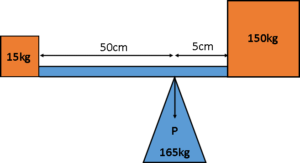 Now if the distances are not the same on both sides, which means there will be a coefficient between the levers, then to obtain balance we’ll have to apply that same coefficient to the loads.
Now if the distances are not the same on both sides, which means there will be a coefficient between the levers, then to obtain balance we’ll have to apply that same coefficient to the loads.
For instance, one lever is 50cm and the other one is 5cm, there is then a coefficient of 10 between them (one is 10 times the other one). If there is a load of 15kg located on the 50cm lever, then to obtain the balance the load on the 5cm lever will have to be 15kg*10(coefficient)=150kg.
The force applied on the fulcrum will then be 15kg + 150kg = 165kg
So you see, depending on the levers the force applied on the fulcrum is completely different, and that is very important to understand because that’s what happens in the body.
Physics applied to the body
If you’re holding a box in your hands, it’s the muscles of your back which will have to contract to create the right force to compensate that load and find the balance (so you won’t fall forward) depending on the lever as we’ve seen above. The force they will create will be calculated and applied to the fulcrum the same way.
If you’re standing straight, holding a 15kg box in your hands close to your body
 • The lever corresponding with the distance between the box and the disc (fulcrum) = 50cm
• The lever corresponding with the distance between the box and the disc (fulcrum) = 50cm
• The lever corresponding with the distance between the disc (fulcrum) and the erector muscles = 5cm (coefficient 10)
• Weight of the load (box) = 15kg
• Force of the contraction of the Erector muscles = 15kg*10(coefficient) = 150kg (well, 1500Newtons but once again we’ll stick with the equivalent in kg for more clarity)
• Weight of the body above the last lumbar disc (fulcrum) = 50kg (for our 75kg person)
• Force applied on the fulcrum (disc L5-S1) = 150kg + 15kg + 50kg = 215kg

So you see, when you’re standing straight and just holding a 15kg box in your hand close to your body, your last disc already has to put up with 215kg of pressure on it, I’m sure you didn’t think it would be that much, am I right?
And that’s not all… because the purpose of this article is to make you understand and realize why it’s important to lift things properly, let’s see what happens when you’re doing it wrong…
First position, our 75kg person is just bending forward at 90°, no box in the hands, but the back is rounded.
When the back is rounded it decreases the distance between the fulcrum (L5-S1) and the erector muscles as the spine is going backwards. It may not be much, maybe 1cm so instead of 5cm it will be 4cm, but when you apply the coefficients it makes a difference.
When you bend forward the center of gravity of your trunk is moving forward too, so the weight of the body above the fulcrum will apply at a distance of that fulcrum creating a lever instead of being applied directly on the fulcrum like when you are standing straight.
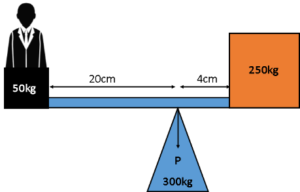 • Lever corresponding to the distance between the disc (L5-S1) and the center of gravity of the trunk = 20cm
• Lever corresponding to the distance between the disc (L5-S1) and the center of gravity of the trunk = 20cm
• Lever corresponding to the distance between the disc and the erector muscles = 4cm (coefficient 5, one lever is 5 times the other one)
• The weight of the upper body = 50kg
• Force of contraction of the erector muscles = 50kg*5(coefficient) = 250kg
• Total force applied on the disc L5-S1 (fulcrum) = 250kg + 50kg = 300kg
So it’s more pressure on your disc if you’re just bending forward with a rounded back than straight and holding a 15kg box in your hands… surprising, isn’t it?
Now, same person, bending forward at 90°, rounded back, holding a 15kg box in his hands.
The calculation will include the constraints of the weight of the box and the upper body, their distances from the disc (fulcrum), and the lever of the erector muscles which will have to compensate for both the weight of the box and the one of the upper body with different levers.
 • Lever corresponding to the distance between the disc (L5-S1) and the box = 50cm
• Lever corresponding to the distance between the disc (L5-S1) and the box = 50cm
• Weight of the box = 15kg
• Lever corresponding to the distance between the disc (L5-S1) and Erector muscles = 4cm
• Force of the contraction for the erector muscles to compensate for the box = 187.5kg
• Lever corresponding to the distance between the disc (L5-S1) and the center of gravity of the trunk = 20cm
• Weight of the upper body = 50kg
• Force of the contraction for the erector muscles to compensate for the upper body = 250kg
• Total force applied on the disc L5-S1 = 250kg + 187.5kg + 50kg + 15kg = 502.5kg
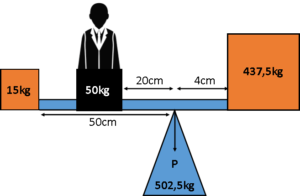
No, you’re not hallucinating… 502.5kg applied on your disc just because of a bad posture, it makes you think about it. Especially since these heavy pressures can favor micro ruptures in the concentric layers of fibers of the disc, creating weaknesses possibly leading to bulging discs and herniated discs. It’s also interesting to note that with a rounded back the pressure won’t be applied evenly on the disc, most of it will be on the front part, stretching the fibers on the back and pushing the nucleus of the disc backward, increasing even more the risks of a herniated disc.
But is it really worth it, are we really saving that much pressure with a proper posture? Well, let’s see!
Again, same person, but with a proper posture, bending forward with a straight back, bending the knees, and holding a 15kg box.
The flexion of the knees and the fact that you can in that posture come closer to the box by spreading your feet allow to decrease the distance between the box and the disc, and so the associated lever (15cm instead of 50cm).
By keeping your back straight you maintain the back lever, avoiding the decrease happening with a rounded back, so keeping it at 5cm instead of 4cm, and the pressure applied on the disc will be more even on the whole surface. Also, the center of gravity of your trunk won’t go as far from the fulcrum (10cm instead of 20cm).
 • Lever corresponding to the distance between the disc (L5-S1) and the box = 15cm
• Lever corresponding to the distance between the disc (L5-S1) and the box = 15cm
• Weight of the box = 15kg
• Lever corresponding to the distance between the disc (L5-S1) and Erector muscles = 5cm
• Force of the contraction for the erector muscles to compensate for the box = 45kg
• Lever corresponding to the distance between the disc (L5-S1) and the center of gravity of the trunk = 10cm
• Weight of the upper body = 50kg
• Force of the contraction for the erector muscles to compensate for the upper body = 100kg
• Total force applied on the disc L5-S1 = 100kg + 45kg + 50kg + 15kg = 210kg

With a proper posture, when you pick up a 15kg box on the floor the pressure applied on your last disc is reduced by about 300kg compared to the position bending forward with a rounded back and straight knees.
So yes, I would say it’s worth it to make the effort of taking the right posture, making it your new habit of lifting things up.
Of course you can always count on us for help fixing your body when you’ve hurt yourself doing the wrong move, misaligning something with a twisting effort, providing it’s something we could fix. But it’s so much better not to reach that point, to prevent that from happening. It’s better to come see us to make sure everything is working properly, aligned so it won’t alter the levers, than coming because you’re suffering from something that could have been avoided.
And as prevention is a big part of Osteopathic Manual Practice, of course we’ll work on your body to help maintain the harmony and efficiency of it, but we’ll also keep telling you to keep your back straight and to use your knees when you lift things up until you really listen to us!

